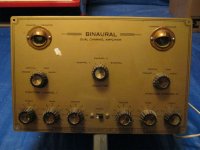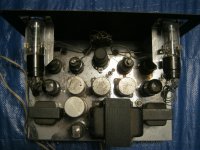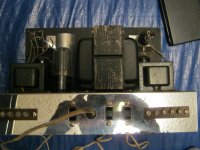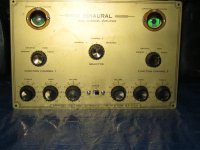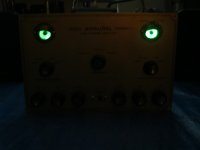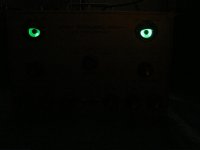I was digging through a hoard of stuff in a warehouse and came across this amp.
Just to cool!
Found a little info with the help of others. It was a kit from the 50s and sold for $40
I gave $50
I cannot upload pics?? I try and when I say Upload the page goes blank and does nothing???
WO
Just to cool!
Found a little info with the help of others. It was a kit from the 50s and sold for $40
I gave $50
I cannot upload pics?? I try and when I say Upload the page goes blank and does nothing???
WO
I was digging through a hoard of stuff in a warehouse and came across this amp.
Just to cool!
Found a little info with the help of others. It was a kit from the 50s and sold for $40
I gave $50
I cannot upload pics?? I try and when I say Upload the page goes blank and does nothing???
WO
If you've only just joined, you won't be able to post pictures until you're not under moderation... I think.
If your file is larger than PHP's (the language that the forum software is written in) max upload limit, then it will throw an exception. If displaying exceptions is disabled in the server's configuration (as is standard practice for production servers), you will see a blank page. This could explain what you're seeing.
If you've only just joined, you won't be able to post pictures until you're not under moderation... I think.
its probably rejected because too big, as said above
I resize to large, which gives around the allowed 90k
then it enlarge big enough for details, when clicking on it
It's OLD. Notice the use of binaural wording and independence of the 2 channels. I'm guessing the rectifier is a 5Y3 and that it uses single ended (SE) 6V6 O/P tubes. Please provide a complete list of the tube complement.
FWIW, I'd salvage the "iron" and tubes for recycling into a new build. All of the electrolytic caps. are "shot". Carbon composition resistors drift in value and go noisy over time, which makes them poor salvage candidates. Wirewound resistors in good physical condition are candidates for salvage.
BTW, if in good condition, the "magic eye" indicator tubes are of value to radio restorers.
FWIW, I'd salvage the "iron" and tubes for recycling into a new build. All of the electrolytic caps. are "shot". Carbon composition resistors drift in value and go noisy over time, which makes them poor salvage candidates. Wirewound resistors in good physical condition are candidates for salvage.
BTW, if in good condition, the "magic eye" indicator tubes are of value to radio restorers.
Well it is very rare for sure. Just finding info was tough, (someone else found it)
It works! Powers up and plays. But I know it needs work.
You have to see these new pictures.
WO
It works! Powers up and plays. But I know it needs work.
You have to see these new pictures.
WO
Attachments
That front panel is just too cool!
I would salvage it "in-place"; i.e. build a new amp into the existing chassis using the existing iron and whatever else is in good condition. Treat it like an old console amp and rebuild it better, faster...
'N it would be really cool if you could do something with the "cats eyes" perhaps replace them with a lens (clear marble perhaps) and put some blue or green LED's that would vary their output with the music.
What was the trouble you found with posting your photo's?
Wow! That thing looks sooooooooooo cool in da dark room - muh-ha-ha-ha
I would also recommend a restoration - I don't know why so many want to instantly junk old equipment :-( without having more info than just a photo or two.
Typically such a late 1950-early 1960 amp can be made in to quite a respectable unit. If it is one of your first efforts in to valve amps then the restoration path has huge learning and experience potential - such as distributed star grounding, testing part values, upgrading electrical safety, adding basic protection devices, appreciating standard circuit designs - and you may be able to find out a bit more of the history of that time.
Later, you can add specialised performance improvement techniques as you become more aware of them - and have had enough time to audition your amp and appreciate whether any change is worth it for your golden ears and speakers. I suggest that your amp would have been close to 'top of the tree' at the time it was made.
Ciao, Tim
Typically such a late 1950-early 1960 amp can be made in to quite a respectable unit. If it is one of your first efforts in to valve amps then the restoration path has huge learning and experience potential - such as distributed star grounding, testing part values, upgrading electrical safety, adding basic protection devices, appreciating standard circuit designs - and you may be able to find out a bit more of the history of that time.
Later, you can add specialised performance improvement techniques as you become more aware of them - and have had enough time to audition your amp and appreciate whether any change is worth it for your golden ears and speakers. I suggest that your amp would have been close to 'top of the tree' at the time it was made.
Ciao, Tim
My vote is restoration.
Check out #3 in this Popular Science magazine New in Electronics for January 1956.
Check out #3 in this Popular Science magazine New in Electronics for January 1956.
Yea, me too. Restore it as is. That front panel is too nice not to use. Besides the other things mentioned to be replaced over time (filter and coupling capacitors and off value resistors) you should definitely replace that old two wire line cord with a three wire grounding cord (and plug) with the green wire connected securely to the metal chassis.
And I think that unit is very rare. I've never seen one before and I've seen a lot. (I'm 68)
And I think that unit is very rare. I've never seen one before and I've seen a lot. (I'm 68)
- Status
- This old topic is closed. If you want to reopen this topic, contact a moderator using the "Report Post" button.
- Home
- Amplifiers
- Tubes / Valves
- Look what I found!

